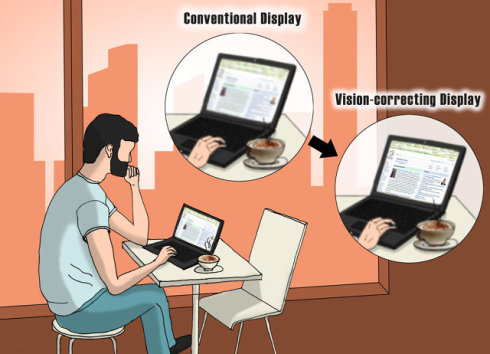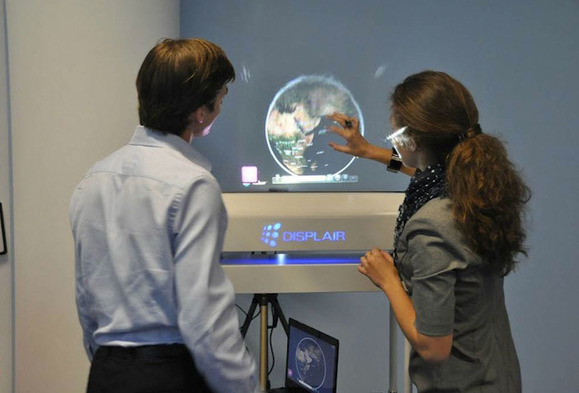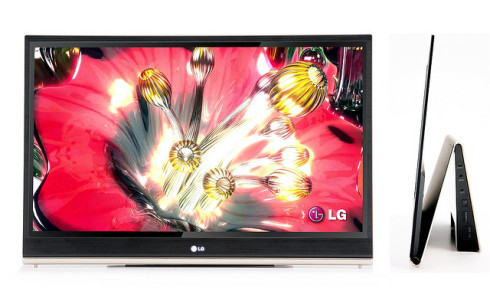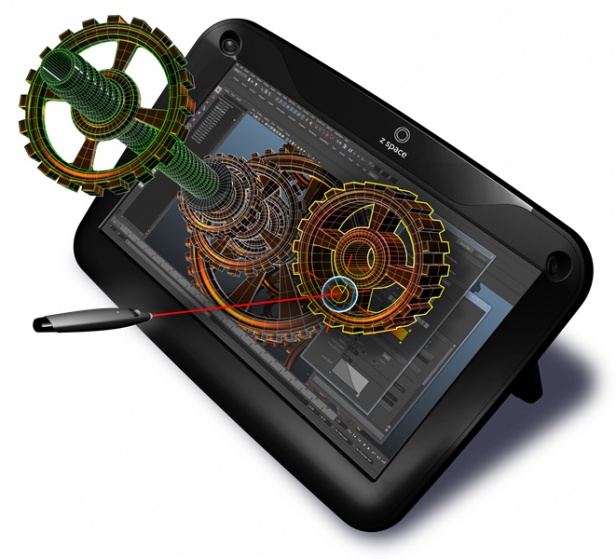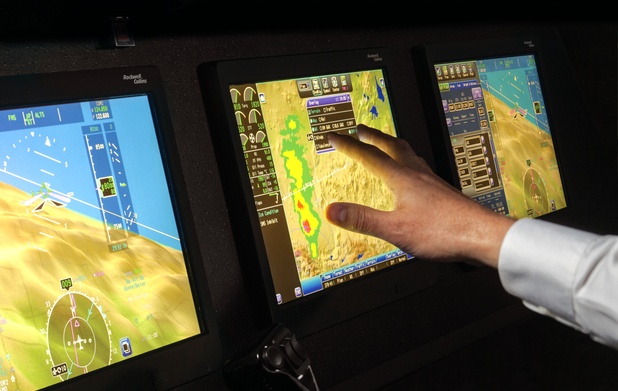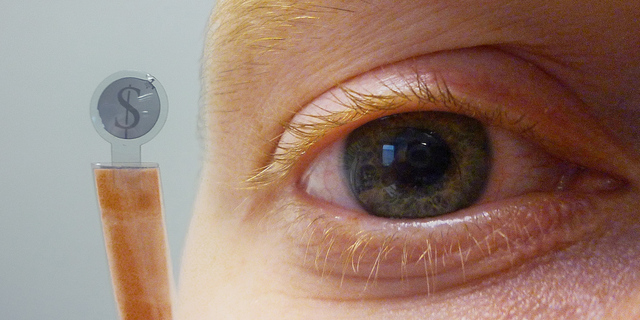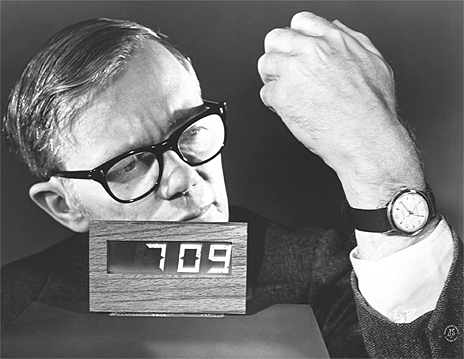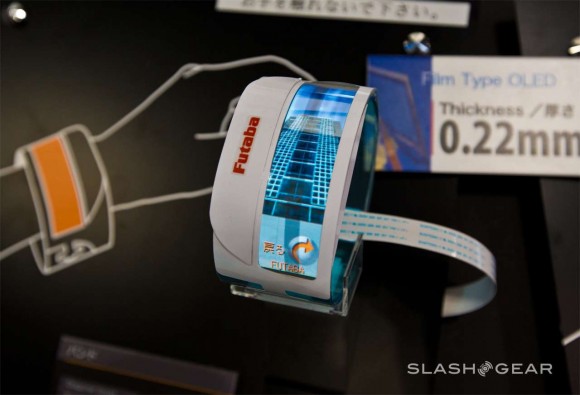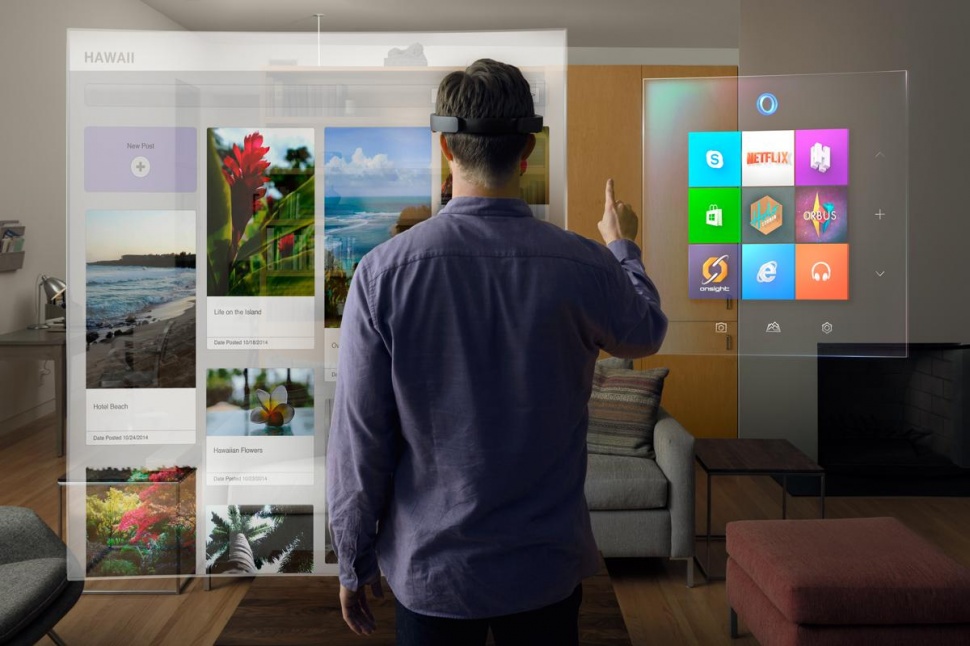
Image via Microsoft HoloLens
Microsoft unveils computer with ‘holographic’ display "Unlike competitors, Facebook-owned Occulus VR and Samsung, Microsoft aims not to immerse the user in an entirely virtual environment but instead to bring the virtual environment into the real world in the form of what it calls “interactive holograms”. HoloLens itself, an unassuming, futuristic-looking headset, will run the latest iteration of Microsoft’s Windows operating system, Windows 10. It is one of the first computers to operate solely using voice and gesture based commands. ...The transparent lenses in front of each eye are made up of three layers of glass, each corrugated with tiny grooves to form diffraction gratings.Visible light is projected onto the lens by a so-dubbed “light engine”, and is diffracted and reflected between the layers of glass, using constructive and destructive interference of the light waves to create a virtual object in the user’s field of view." via Electronics Weekly
Apple Inc. Teams Up With Japan Display For LCD Production "Apple is reportedly in talks with Japan Display to help finance an LCD display factory in Ishikawa something next year. Japanese publication, Nikkan Kogyo, has reported that the deal is still in the works, and Apple is expected to invest around 200 billion yen ($1.7 billion) into this strategic partnership. The factory would be responsible for manufacturing low-temperature polycrystalline silicon displays utilized in the iPhone 6 and 6 Plus. Moreover, the Japanese publication states the factory will also be used to make OLED panels like the ones being used in the upcoming Apple Watch, slated for release in April." via Bidness Etc
Quantum dots: How nanocrystals can make LCD TVs better "Quantum dots are microscopic nanocrystals that glow a specific wavelength (i.e. color) when given energy. The exact color produced by the QD depends on its size: larger for longer wavelengths (redder colors), smaller for shorter wavelengths (bluer). That's a bit of an oversimplification, but that's the basic idea. Specific wavelengths of color is what we need to great an image on a television. Using the three primary colors of red, green, and blue, we can mix a full rainbow of teals, oranges, yellows, and more. Plasma and CRT televisions used phosphors to create red, green, and blue. All LCDs use color filters to do the same. There are multiple ways to use QDs in a display." via CNET
FlexEnable and Merck Take Major Step Forward in Plastic LCD Technology "A plastic LCD has been developed which is completely free of glass, instead using organic transistors on a plastic sheet, offering multiple benefits. Plastic LCDs have the potential of making products ten times thinner, more than ten times lighter and cheaper than conventional glass-based displays - all while delivering differentiating product benefits of being shatterproof and even conformal. The demonstrator was developed in a very short timeframe, and combines the key benefits of organic transistor technology (OTFT), including superior quality and yield. Ultimately, it shows a route to low-cost solutions for volume manufacturing with LCDs, the dominant display technology in the market today. FlexEnable has now demonstrated the world's first plastic LCD with active-matrix in-plane switching (IPS). It uses FlexEnable's OTFT array as well as liquid crystal (LC) and organic semiconductor materials from Merck. While the first demonstrator employs an IPS mode, this concept will be equally attractive for many other LC modes and applications such as e-readers, dynamic public signage and advertising. " via PR Newswire
Tech Time Machine: Screen and Display Technology History "'80s and '90s - Touchscreen Invades. IBM, Microsoft, Apple, HP and Atari are among just a few of the tech companies bringing touchscreen into the mainstream in this era. In 1992, IBM's Simon is the first phone with a touchscreen. FingerWorks, a gesture recognition company that is later acquired by Apple, produces a line of multi-touch products in 1998." via Mashable
Why are display makers looking to next-generation cars to drive growth? ""Previously, display makers saw little merit in auto displays because of their small volumes and slim margins ...but they are now revising their strategy as the market is growing," said Lee Byeong-hoon, a principal engineer at the South Korean unit of German auto parts giant Continental, the biggest buyer of automotive displays. Luxury cars already carry two or three displays and could have as many as nine in the near future, as safety and convenience features proliferate. Kia Motors' K9 sedan, for example, has five displays - an instrument panel, a centre information screen, two backseat displays and a "head-up" display projecting information onto the windshield. Future cars could add transparent side-window displays and replace rearview mirrors and side mirrors with screens, according to LG Display, the biggest liquid crystal display (LCD) maker." via The Star
Display database for engineers Search thousands of display panels by multiple characteristics and compare results side-by-side using the display database multisearch.
How does rewritable paper print with light rather than ink "A new type of paper can be used and reused up to 20 times. What’s more, it doesn’t require any ink. Its designers think that this new technology could cut down on tons of waste — and save people tons of money. A special dye embedded in the paper makes it printable and rewritable. The dye goes from dark to clear and back when chemical reactions move electrons around. (Electrons are the subatomic particles that orbit in the outer regions of an atom.) The paper’s color-change chemical undergoes what are known as redox reactions. Redox is short for reduction and oxidation." via Student Science
Xerox licenses Thinfilm printed storage tech for smart labels "The Norwegian printed electronics firm Thinfilm has formed a strategic partnership with Xerox around printed storage. Xerox will license Thinfilm’s proprietary technology and make Thinfilm Memory labels, which have some very interesting characteristics. Each label, costing a few pennies, is a plastic tag that’s based on ferroelectric capacitors and allows for power-free archival storage in the 10-15-year range. This isn’t some data center technology though; we’re only talking 10-36 bits. They are however very rewriteable – the data can be rewritten 100,000 times. This means the labels are perfect for continually storing and refreshing the output of sensors." via Gigaom
Pixel QI is Officially out of Business "Pixel Qi first first established in 2008 by Mary Lou Jepson and her husband John Ryan took over the reigns as CEO in November 2012. Mary left the company in March of 2013 to become Head of Display Division at Google X. John followed her in September to become the Director Program Management at Google X. With a non-existent executive team and no display prospects for the future, for all sense and purposes, Pixel Qi is out of business. The company designs liquid crystal displays (LCDs) that can be largely manufactured using the existing manufacturing infrastructure for conventional LCDs. The advantage of Pixel Qi displays over conventional LCDs is mainly that they can be set to operate under transflective mode and reflective mode, improving eye-comfort, power usage, and visibility under bright ambient light." via Good e-Reader
How Quantum Dots Are Taking a Quantum Leap "Outside his career as a noted nanochemist, Lawrence Berkeley National Laboratory director Paul Alivisatos is an avid photographer. To show off his photos, his preferred device is a Kindle Fire HDX tablet because “the color display is a whole lot better than other tablets,” he says. What he may neglect to mention to the viewer is that not only did he take the photograph, he also helped invent the nanotechnology allowing the viewer to see those brilliant greens, rich reds, and bold blues, all while using significantly less energy. In fact, the Kindle display utilizes a technology manufactured by Nanosys, a startup Alivisatos cofounded in 2001 to commercialize quantum dots. ...Since then, Berkeley Lab’s quantum dots have not only found their way into tablets, computer screens, and TVs, they are also used in biological and medical imaging tools, and now Alivisatos’ lab is exploring them for solar cell as well as brain imaging applications." via Controlled Environments
Japan Display unveils low-power screen for smartwatches "Japan Display’s new screen could reduce power consumption dramatically since it’s designed to show color text and graphics without a backlight. Not only does that mean the screens use less power than traditional LCD displays, but they’re also easier to view in direct sunlight. Japan Display says its screens also feature memory built into the pixels of the display, allowing a watch to display a static image without using much electricity." via Liliputing
Do you have content to share with Display Alliance? Anyone can post press releases, white papers, commentary, videos, and more in the open section.
Glasses-free 3D could revolutionise advertising and cinema "In 2013, the young start-up company TriLite Technologies had the idea to develop this new kind of display, which sends beams of light directly to the viewers' eyes, andhas been working with the Vienna University of Technology to create the first prototype. Currently it only has a modest resolution of five pixels by three, but it clearly shows that the system works. 'We are creating a second prototype, which will display colour pictures with a higher resolution. But the crucial point is that the individual laser pixels work. Scaling it up to a display with many pixels is not a problem', says Jörg Reitterer (TriLite Technologies and PhD-student in the team of Professor Ulrich Schmid at the Vienna University of Technology)." via Daily Mail
Startup developing full-color holographic display for mobile devices images and video. "Fattal’s company, appropriately named Leia, will demonstrate a prototype of its new 3-D display next week at Mobile World Congress in Barcelona. Later this year it plans to release a small display module capable of producing full-color 3-D images and videos that are visible—with no special glasses—from 64 different viewpoints.Key to Leia’s technology is an invention by Fattal that takes advantage of advances in the ability to control the paths light takes at the nanoscale. He first revealed the concept, which Leia calls a “multiview backlight,” in a Nature paper published two years ago. At the time, Fattal was a researcher at HP Labs and his work applied to optical interconnects, which allow computers to exchange information encoded in light. But he realized that the idea could also be used to display holographic images, and he left Hewlett-Packard to pursue that idea." via MIT Technology Review
New Technology Will Make Fonts Look Great on Small Screens "Monotype debuted Spark, a technology that consumers can’t even buy. In fact, a measure of Spark’s success down the line might be how few, not how many, people notice it. That’s because Spark is a new software program from Monotype meant to make fonts on tiny screens, like on smartwatches and digital dashboards in cars, as intuitive and legible as the ones on your computer. The problem with fonts on small screens has to do with bitmap fonts, which get pre-coded into devices because they require less computational power. Unfortunately, those bitmap fonts are pixelated, so they won’t allow for the beauty and flexibility of rendered fonts—like Times New Roman or Helvetica—which scale more easily and can be found on bigger computer screens with plenty of power. That poses a problem for manufacturers peddling luxury goods, because a crappy screen display could easily cheapen even the most beautiful of devices. This where Monotype’s new software comes in." via Wired
Tackling the "achilles' heel" of OLED displays "Kateeva aims to “fix the last ‘Achilles’ heel’ of the OLED-display industry — which is manufacturing,” says Kateeva co-founder and scientific advisor Vladimir Bulovic, the Fariborz Maseeh Professor of Emerging Technology, who co-invented the technology. Called YIELDjet, Kateeva’s technology platform is a massive version of an inkjet printer. Large glass or plastic substrate sheets are placed on a long, wide platform. A component with custom nozzles moves rapidly, back and forth, across the substrate, coating it with OLED and other materials — much as a printer drops ink onto paper. An OLED production line consists of many processes, but Kateeva has developed tools for two specific areas — each using the YIELDjet platform. The first tool, called YIELDjet FLEX, was engineered to enable thin-film encapsulation (TFE). TFE is the process that gives thinness and flexibility to OLED devices; Kateeva hopes flexible displays produced by YIELDjet FLEX will hit the shelves by the end of the year." via R&D Magazine
Are you an engineer or have display expertise? Email jason@displayalliance.com to be featured in the interviews section.
Magic Leap CEO says Stereoscopic 3D may cause permanent brain damage "Recently the CEO of a Google backed start up Magic Leap has claimed Microsoft's HoloLens could cause permanent brain damage and to no one's surprise Magic Leap has a 'better' and 'safer' competing product. Without giving any details Rony Abovitz, the CEO of Magic Leap, says consumers should avoid HoloLens when it comes out and stick to products made with superior technology. "There are a class of devices (see-through and non-see-through) called stereoscopic 3D. We at Magic Leap believe these inputs into the eye-brain system are incorrect -- and can cause a spectrum of temporary and/or permanent neurologic deficits." - Abovitz" via WinBeta
Intel snaps up Swiss eyewear startup "Just as Google has stepped back from making networked eyewear, Intel is stepping into the gap with the purchase of Swiss startup Composyt Light Labs for an undisclosed amount. ...Most of the near-eye display technologies behind smart glasses involve some sort of trade-off. They either, like Google Glass, only show information in a small area over the eye, or are often too bulky to be practical. Composyt's smart glasses feature a patented see-through display architecture that shows images over a field of vision of 40 degrees on normal eyewear. The startup says the fact that its product works with standard and prescription glasses, has a large image size, and very high transparency will appeal to enterprises, where practicality is more important than designer style." via ZDNet
Displio Is A Tiny E-Ink Display That Runs Programmable Widgets "The Displio is the latest in a line of Internet-connected ‘displays’ designed to sit on a desk, or perhaps on a shop counter, and exhibit various online information, such as Facebook ‘Likes’, weather, number of unread email, and so on. However, although similar to the LaMetric, a fully-programmable but simple, ticker-style Internet-connected display, the Displio is considerably smaller, housing a 2.7 inch e-ink screen. Not only does this change the aesthetics considerably, and allows for a greater amount of information to be displayed, but e-ink’s lower power consumption — requiring power upon refresh only — means the Displio claims to be able to run on a single charge for up to a month." via TechCrunch
'Phorm' Case Adds Morphing Tactile Keyboard to iPad Mini "For the last several years, Tactus Technology has been working on displays that take advantage of microfluidic technology, with buttons that raise up and disappear on demand for a superior touchscreen typing experience. ...Here's how it works: there are a series of small channels filled with fluid behind an elastomeric panel (aka the screen protector portion of the case) and when activated by the slider, pressure is introduced, causing the fluid to come up through the channels and into holes, where it presses against the elastomer, physically changing and morphing the display portion of the case to create buttons. In the opposite slider position, the pressure is released and the buttons disappear as the liquid is dispersed back into the channels. (Video)" via MacRumors
Glyph head-mounted display shoots DLP images directly into your eyeballs "Rather than use an OLED display to provide an image, the Glyph uses a pair of small DLP arrays to bounce light directly onto the wearer’s retinas. This results in a very clear, very bright pixel-free image with an extremely high effective refresh rate. According to founder and chief strategy officer Edward Tang, Avegant started out with the intention of marketing its MEMS-based DLP display technology to the military, before the sudden explosion in the consumer market (driven, as Tang says, in no small part by Oculus) led him to retarget the technology at consumers. This has taken the form of a pair of chunky, oversized headphones, with the DLP components hidden in the connecting band. The idea is that you could wear the final production version of the Glyph (mostly) unobtrusively, and then perhaps flip the band down over your eyes when you’re on the train or something similar and want to watch a movie." via Ars Technica
See how different touchscreens were back in 1982 "While modern touchscreen displays use either a resistive or capacitive display to sense what your finger is touching, touchscreens in 1982 actually used a grid of intersecting infared light beams. When your finger touched the glass of the display, it would interrupt the horizontal and vertical infared light beams, sending a coordinate of where your finger was to the TV. (Video)" via Business Insider
DARPA developing neural display interface connected to your spine "The US military’s advanced research division – DARPA – has revealed details of its ‘cortial modem’ which wants to turn the inside of the human eye into an advanced display powered by the spine. Revealing details of its plans at an event called Biology is Technology (BiT) in the US, the organisation and its director Dr Arati Prabhakar said that their eventual goal is to an internal display system that would look as if you were wearing a Google Glass-style headset, but without any external technology. According to H+, DARPA’s short term goals are to begin by creating a small device that would cost no more than US$10 of showing a basic digital display, similar to a digital clockface, through a direct interface with the visual cortex." via Silicon Republic
Top 5 problems with HMIs (Human Machine Interfaces) "Backlit villains - When choosing a HMI, parameters such as display life, picture quality, and display brightness all need to be factored into the process in correspondence to the application. There's no need to get a super bright and or high quality interface if it's only used rarely or for menial tasks. Brightness often means heat. What you have to remember is that heat seriously affects the life of a backlight and, although some HMI manufacturers try to make bulbs easy to replace, it is more common for the entire unit to be replaced instead. This is obviously more costly and so efforts to reduce overheating and overuse should be made." via Process and Control Today
Sapphire Glass: Engineering vs. Physics "This long intro is a preface to discussion of Apple's recent decision to spend $2 Billion to convert the GTAT facility into a data center. Clearly Apple is giving up on sapphire, otherwise GTAT or some restructured version of it might be useful going forward. This would tend to show that Apple ran into a Physics Problem in converting from glass to sapphire, not: cost or yield issues, design issues, tooling or such. Sapphire actually had to physics issues fundamental to the nature of the material. As described in "Big Surprise," although sapphire was harder and more scratch resistant than glass, with that hardness came brittleness. Secondly, and more importantly, sapphire has a higher index of refraction meaning that screens made with a sapphire overlay would have much higher surface reflections than glass." via Norm Hairston's Flat Panel Display Blog
What did you think about today's news? Leave a comment here and share your thoughts.

 Display Alliance
Display Alliance


